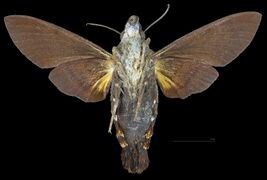Biology:Macroglossum corythus
| Macroglossum corythus | |
|---|---|

| |
| Scientific classification | |
| Domain: | Eukaryota |
| Kingdom: | Animalia |
| Phylum: | Arthropoda |
| Class: | Insecta |
| Order: | Lepidoptera |
| Family: | Sphingidae |
| Genus: | Macroglossum |
| Species: | M. corythus
|
| Binomial name | |
| Macroglossum corythus Walker 1856
| |
| Synonyms | |
| |
Macroglossum corythus is a species of hawk moth of the family Sphingidae. It was described by Francis Walker in 1856 and is found throughout the Indo-Australian tropics east to New Caledonia.[1][2]
Description
The wingspan is 50–66 mm. The coloration is varying slightly in subspecies and climate of the country. Head, thorax and abdomen is rufus in color. Abdomen is without the lateral black marks on distal segments. The anal tufts are ruddy at tips. Forewings with all lines are obsolescent, where the postmedial lines less bent. The markings being reddish and ill-defined. Hindwings with the band are pure yellow and band is narrow.[3]
Larva is dark violet brown with dorsal specks. There is a subdorsal yellow line on the 2nd and 4th somites and 10th and 11th somites. The horn is long and tuberculate. In a later stage, there are yellow and olive-brown transverse dorsal lines and yellow lateral spots. Larvae have been recorded from Loganiaceae and Rubiaceae species. Pupa is bone colored with a black dorsal stripe on the frons and thorax.[4][5]
Subspecies
- Macroglossum corythus corythus (Sri Lanka, southern India)
- Macroglossum corythus luteata Butler, 1875 (north-eastern India, Bangladesh, Andaman and Nicobar Islands, Thailand, eastern and southern China, Taiwan, Japan (Tsushima Island), Malaysia (Peninsular, Sarawak, Sabah), Indonesia (Sumatra, Java, Kalimantan, Flores, Sumba, Sulawesi), the Philippines (Palawan, Mindanao, Luzon), Vietnam)
- Macroglossum corythus oceanicum (Rothschild & Jordan, 1915) (Chagos)
- Macroglossum corythus platyxanthum Rothschild & Jordan, 1903 (southern Japan)
- Macroglossum corythus xanthurus Rothschild & Jordan, 1903 (Tenimber)
- Macroglossum corythus pylene Felder, 1861 (New Guinea, Amboina, Buru, Moluccas)
- Macroglossum corythus novirlandum D'Abrera, 1986 (Bismarck islands)
- Macroglossum corythus novebudensis Clark, 1926 (New Hebrides)
- Macroglossum corythus fulvicaudata Butler, 1882 (New Britain)
- Macroglossum corythus fuscicauda Rothschild & Jordan, 1903 (Loyalty Islands)
Macroglossum corythus luteata and Macroglossum corythus oceanicum are treated as species (Macroglossum luteata and Macroglossum oceanicum) by some authors.
References
- ↑ "Macroglossum corythus Walker". http://www.mothsofborneo.com/part-3/sphingidae/sphingidae_28_9.php. Retrieved 6 July 2016.
- ↑ "The Hawkmoths (Sphingidae, Macroglossinae) of Papua Indonesia". Papua Insects Foundation. http://www.papua-insects.nl/insect%20orders/Lepidoptera/Sphingidae/Macroglossum/Macroglossum%20corythus.htm. Retrieved 6 July 2016.
- ↑ Hampson, G. F. (1892). The Fauna of British India, Including Ceylon and Burma: Moths Volume I. Taylor and Francis. https://www.biodiversitylibrary.org/item/180068#page/5/mode/1up. Retrieved 2018-01-14.
- ↑ Pittaway, A. R.; Kitching, I. J. (2018). "Macroglossum corythus luteata Butler, 1875". http://tpittaway.tripod.com/china/m_lut.htm. Retrieved December 15, 2018.
- ↑ "Macroglossum corythus". Butterfly House. http://lepidoptera.butterflyhouse.com.au/sphi/corythus.html. Retrieved 6 July 2016.
External links
- Pinhey, E. (1962): Hawk Moths of Central and Southern Africa. Longmans Southern Africa, Cape Town.
- Barnett, L. K.; Emms, C. W.; Holloway, J. D. (July 1, 1999). "The moths of the Chagos Archipelago with notes on their biogeography". Journal of Natural History 33 (7): 1021–1038. doi:10.1080/002229399300065.
- Pittaway, A. R.; Kitching, I. J.. "Macroglossum corythus platyxanthum Rothschild & Jordan, 1903". http://tpittaway.tripod.com/china/m_pla.htm.
Wikidata ☰ Q2182753 entry
 |



